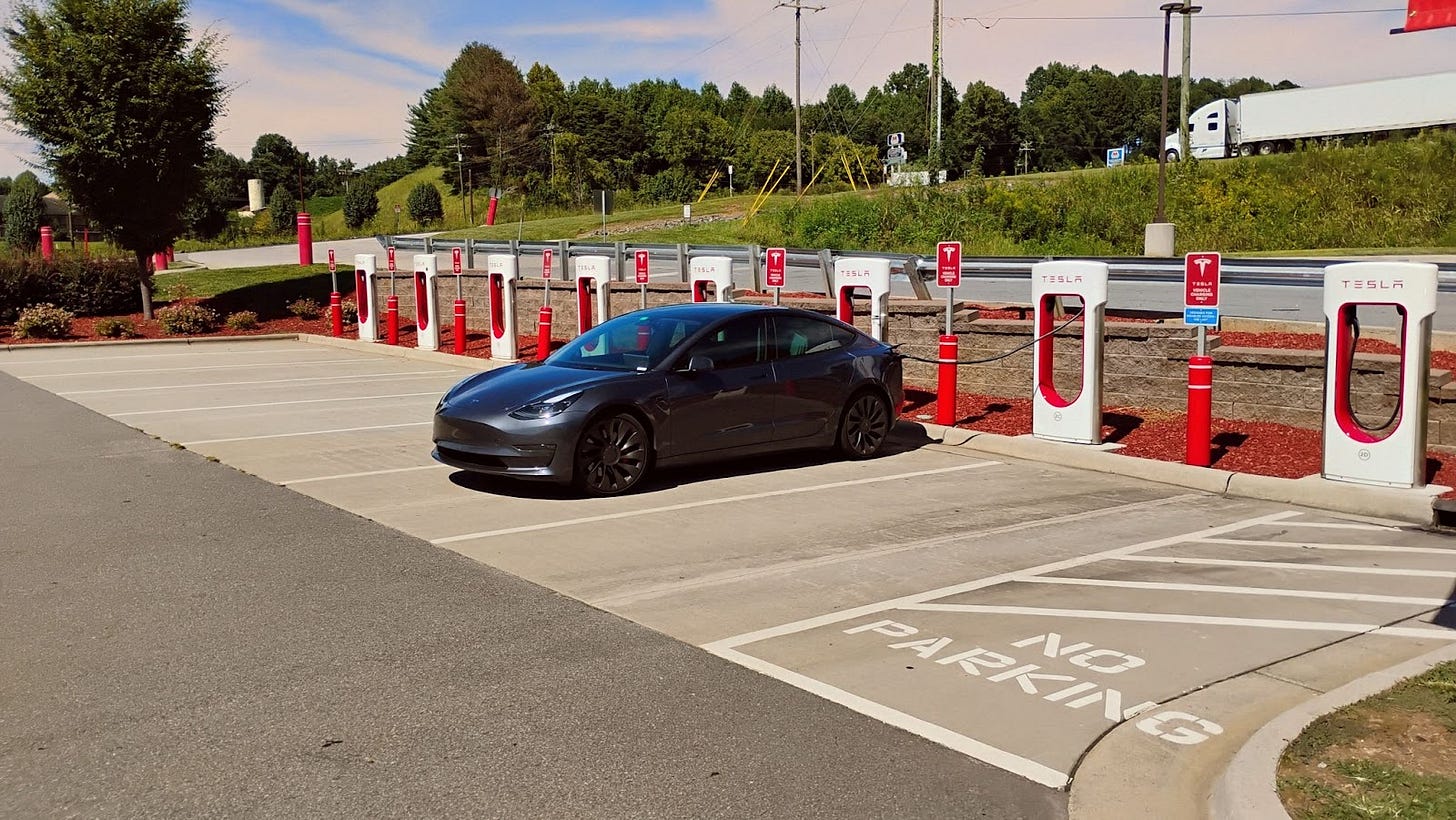Tesla Road Trip: Myths vs. Reality
Cost, charging, range anxiety - everything you need to know about long-distance Tesla travel.
So, earlier this summer, my wife suggested we do another road trip to a destination approximately 1,000 miles from our home in Florida. I welcomed the idea as I looked forward to another experiment since we would use the all-electric Tesla Model 3 Performance. If you know me, I like doing experiments; in the past, I’ve spent a summer without a smartphone, drove for Lyft for three weeks, etc.
This article is for long-time Tesla owners and those who feel they would never own an electric car. I hope to answer questions I get almost daily and dispel some myths. The road trip would take place over about a week, and I discuss the cost, charging issues, etc. After all, our destination city is a Tesla Supercharging Station desert with no reliable charging for 30 miles. Skip to the last section of this article to get my key takeaways/tips.
Before we left, I let the car map our route, which included necessary charging stations along the way (right off major highways). But I was surprised the closest Tesla Supercharging Stations in our destination city were 30 minutes away. So, I downloaded an EV charging app; this made me feel better because there were plenty of places to get a charge while in town. Little did I know, half of them didn’t work or were very slow.
Also, during the drive to the destination, I was worried about how long we’d be at each Tesla Supercharging station, and the Internet is full of conflicting advice for EV road trips. Some say they charge 100% at each station, while others charge only 80%. Ultimately, Elon opined on this issue, and ultimately, I decided to charge 100% at our start point while charging 80% at each charging station.
COST TO CHARGE vs. GAS
A common question is the cost of charging a car compared to gas cars. This is all anecdotal, of course, but I make four-hour, 300-mile roundtrip drives monthly. During those trips, my gas vehicle would cost between $35-40 roundtrip, whereas in my Tesla, the same trip costs between $12-14 at a Tesla Supercharger in South Florida; but that is partial because it is not a long road trip, and can charge at home at the start and end of the 300-mile roundtrip drive.
So for this long road trip of approximately 2,000 miles roundtrip, the cost to charge came to $185.89 (the entire trip). The price at each charging station ranged from $.25 to $.40 per kW. For a gas car, I will use the national average regular gas price of $3.29 and the average MPG of 33 (your vehicle may differ, so calculate accordingly); the trip would have cost $199.39. So, there was little difference in cost per mile while on a road trip. A Tesla shines with its cost per mile when driving from home normally. The cost to charge at home is dramatically less by at least half of what you’d pay out in the wild at a Tesla Supercharging Station. Additionally, there is no need for oil changes. If you can charge at home under one of these utility EV programs (like FPL’s EV program), then you may not pay more than $38 per month to fuel your vehicle for the month -- much less than a gas car (depending upon how many miles you may drive in a typical month).
My energy usage for the Tesla this year has saved me $3,180 over if I was driving a gas car (not including oil changes and other non-ev maintenance costs). I have spent just under $3,000 on Tesla; a gas car would cost around $6,200 in fuel costs.
TIME TO CHARGE
The time it takes to charge at each station varies dramatically due to several factors. The road trip took anywhere from 10 to 40 minutes at each station. Hopefully, you’ve entered the charging stations into your navigation so the battery pack will be “preconditioned” before arrival, which will shorten your time there. Also, depending on the station, it could go super fast, depending upon its overall capacity and the number of cars there.
RANGE
The Tesla range we used usually got us 200 to 250 miles on one charge, driving at around 80 miles per hour. One could get further on each charge if they drive slower, but after 2-3 hours, it’s good to stretch your legs, use the restroom, get a coffee, have lunch, etc. We will watch Netflix or YouTube on the car’s screen while having a snack during the charge time.
THE DIFFERENCE BETWEEN REGULAR EV CHARGING AND TESLA SUPERCHARGING STATIONS
Your car's charging at a Tesla Supercharger is seamless and frictionless, just how it should be. In contrast, other EV charging stations suck. Many of them are out of service and are very slow. No wonder people who own non-Tesla electric vehicles are frustrated with their experience and go back to gas cars. There is a reason most other EV manufacturers are working with Tesla, and Tesla Supercharging is becoming the standard. Recently, I have seen Ford F-150 Lightning, Mercedes EQS, and other Ford EVs charging at Tesla Supercharging Stations.
My TIPS AND KEY TAKEAWAYS FOR TESLA ROADTRIPS
Use Autopilot as much as possible to reduce strain and stress. Use FSD starting with the October 2024 update, when it will be at its best (I still don’t trust it 100%).
Bring snacks and drinks.
If your destination city doesn’t have a Tesla Supercharger nearby, charge 90-100% at the closest one, so you have plenty of charge while in the city. Also, you may want to turn off energy leaches like Cabin Overheat Protection and perhaps Sentry Mode in such situations.
Use a long-range Tesla instead of a performance version if you plan to do regular long road trips.




